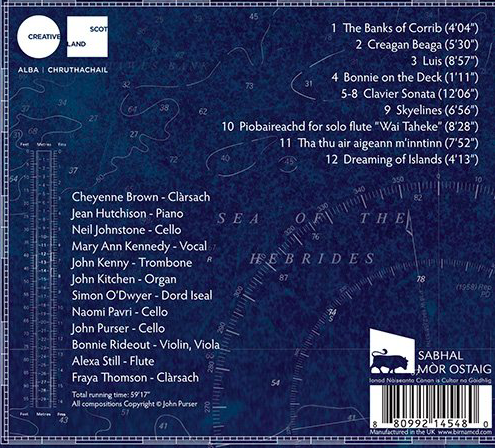 Image 1 of 2
Image 1 of 2

 Image 2 of 2
Image 2 of 2



Eddie McGuire: Ae Fond Kist for solo organ (2010)
Handwritten Score by the composer, scanned to PDF for immediate download. [8pp]
Composer Programme Note:
To open, a bright fanfare (built from snippets
of Burns song phrases) descends from the high 4' Flute. It is this material
that the rest of the piece grows from, with memories and phrases of Burns
song arising as naturally as possible along the way, embedded in the texture.
Hints of the musical style of the period appear and dissolve. Songs alluded to
include Charlie He's My Darling (1794) - and, after a jig-like passage - Ae
Fond Kiss (1791) and one of my favourite tunes I like to improvise on with
my flute, The Winter It Is Past (1788). These appear again after a more rapid
passage with a hint of Coming Thro'the Rye (1795). A 9/8 section presents
melody from My Tocher's the Jewell (1792) while , following an almost
minimalist fast section, The Slave's Lament provides more sombre reflection.
Phrases from For a' That and a' That (1795) together with a recall of earlier
themes bring the music to a conclusion.
Commissioned by Paul Baxter of Delphian Records for the CD book
'Organs of Edinburgh' with funding from the Scottish Arts Council,
especially for the 1756 Snetzler organ in The Royal Order of Scotland
off Canongate in Edinburgh.
Handwritten Score by the composer, scanned to PDF for immediate download. [8pp]
Composer Programme Note:
To open, a bright fanfare (built from snippets
of Burns song phrases) descends from the high 4' Flute. It is this material
that the rest of the piece grows from, with memories and phrases of Burns
song arising as naturally as possible along the way, embedded in the texture.
Hints of the musical style of the period appear and dissolve. Songs alluded to
include Charlie He's My Darling (1794) - and, after a jig-like passage - Ae
Fond Kiss (1791) and one of my favourite tunes I like to improvise on with
my flute, The Winter It Is Past (1788). These appear again after a more rapid
passage with a hint of Coming Thro'the Rye (1795). A 9/8 section presents
melody from My Tocher's the Jewell (1792) while , following an almost
minimalist fast section, The Slave's Lament provides more sombre reflection.
Phrases from For a' That and a' That (1795) together with a recall of earlier
themes bring the music to a conclusion.
Commissioned by Paul Baxter of Delphian Records for the CD book
'Organs of Edinburgh' with funding from the Scottish Arts Council,
especially for the 1756 Snetzler organ in The Royal Order of Scotland
off Canongate in Edinburgh.

![Edward McGuire: Dialogue of Flute and Organ [download]](https://images.squarespace-cdn.com/content/v1/5f3690f6995b741710ab4824/1612284359412-ERJ2KLLL7SC4IDT6Z40U/mcguire-dialogiue.png)



![Michael Bonaventure: Dragon [download]](https://images.squarespace-cdn.com/content/v1/5f3690f6995b741710ab4824/ad87a53d-32fe-40a7-b1e7-6aff79f42f2c/1.png)

![Michael Bonaventure: Typhon [download]](https://images.squarespace-cdn.com/content/v1/5f3690f6995b741710ab4824/3befde17-6ac2-4180-b450-fbd8b5e4adb5/4.png)

![Rory Boyle: Three Pieces for Organ [download]](https://images.squarespace-cdn.com/content/v1/5f3690f6995b741710ab4824/1612463310869-2T99BO27EHH094CQORGF/boyle-organ.png)




